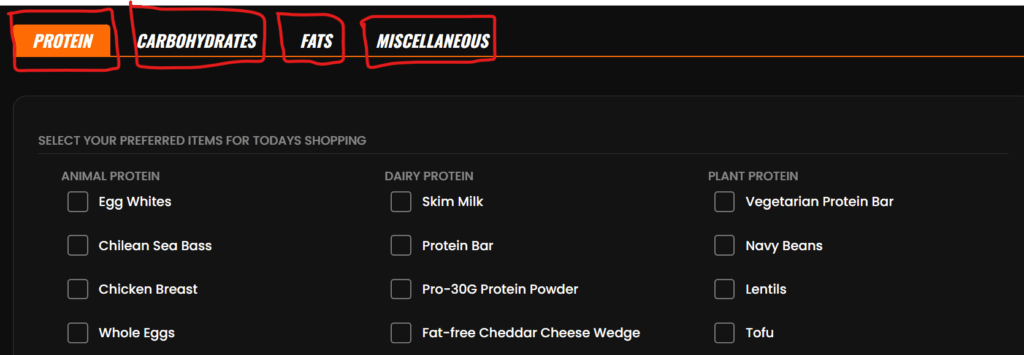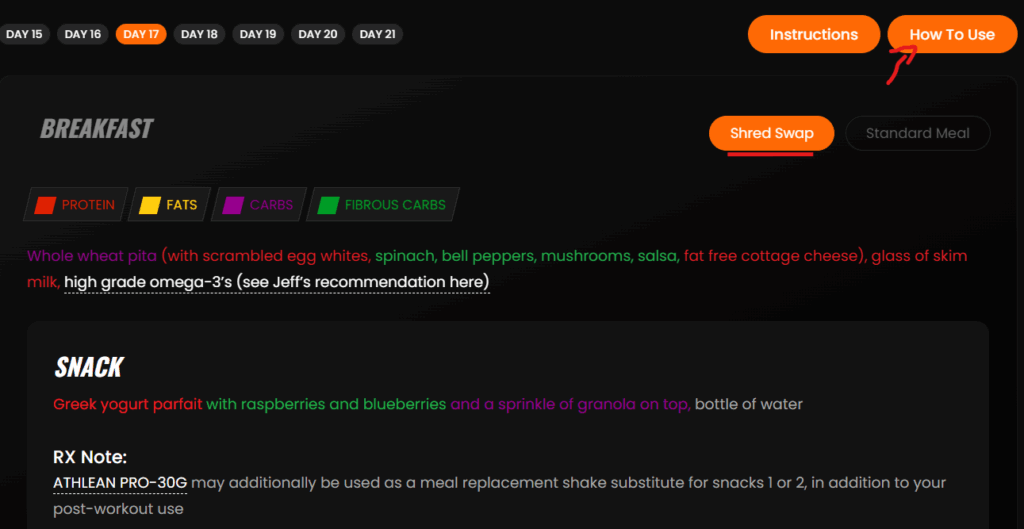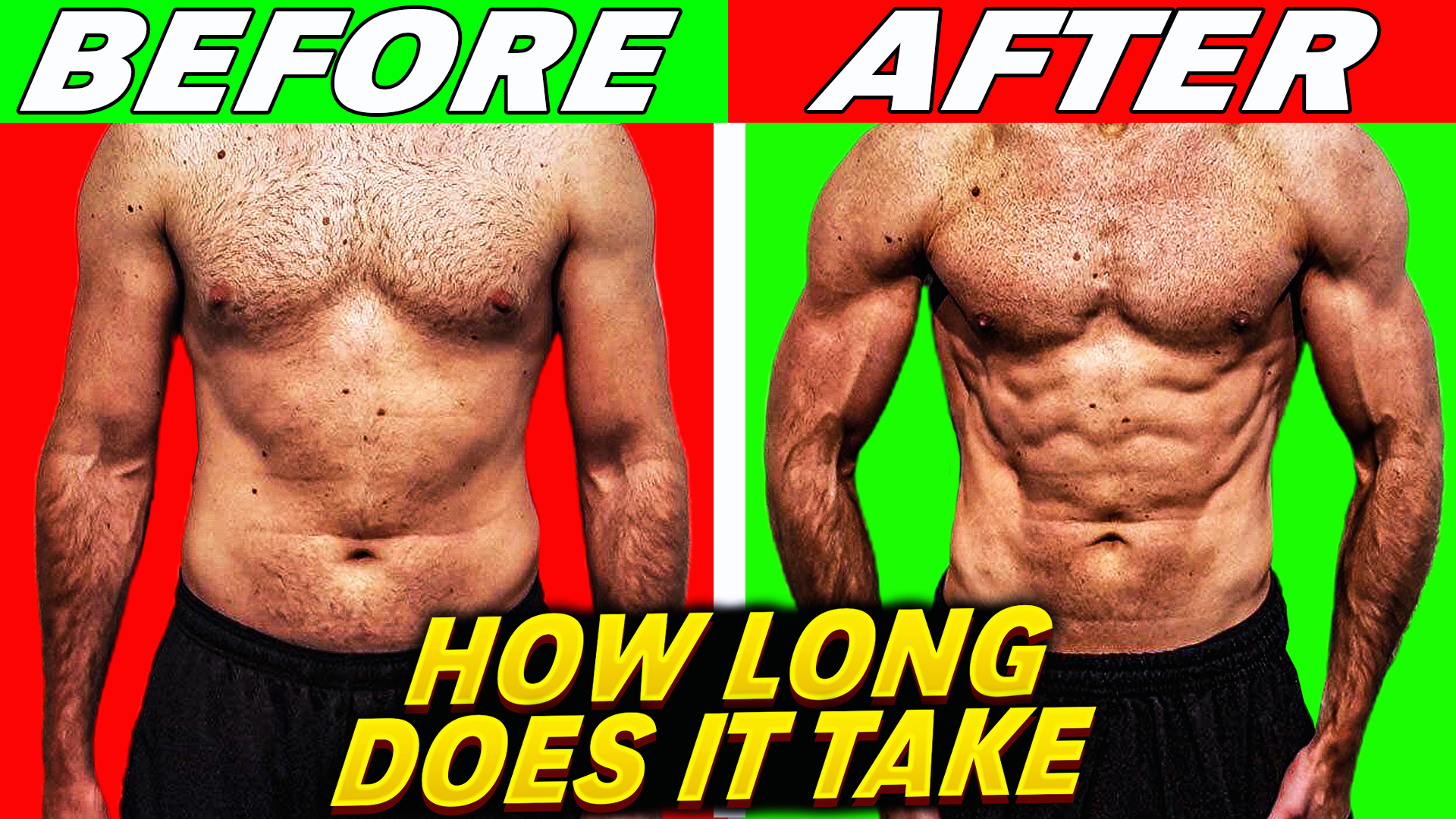A couple years ago I decided to buy the program from Athlean X called MaxShred, which is supposed to help you reach extremely low levels of body fat. Who doesn’t want to have a ripped six pack, right?
I believe most of us would answer yes, so in this article I am going to do an in-depth analysis of the program and share with you whether or not I believe it is worth buying.
First of all, it is worth mentioning that Jeff has a lot of programs. Some focus on building as much size as possible, others use only bodyweight training, and this one is mainly about losing fat. There is a reason I am bringing that up, and I will come back to it later.
The program lasts for three months, and by the end of it you should be able to achieve your desired results. So let’s start with the nutrition part of the program. Jeff provides a shopping list with all the ingredients needed to follow his meal plan.

I will not be showing all the items in the list, as that would be against the rules, but he includes a lot of options which I think is extremely important. Having variety helps you avoid getting bored of eating the same things over and over again. He also organizes the list into different sections like proteins, carbs, fats, and toppings, which I found really helpful and easy to follow.
The meal plan also comes with a guide on how to use it, which makes sense since everyone is different and has their own specific needs.

One thing before starting with the program si to read the 10 athlean axioms as Jeff likes to call it, basically his 10 tips for following along, we will go through each point and im gonna be sharing my thoguhts.
Axiom 1 – No need to track calories.
Jeff’s first rule is to completely forget about calorie counting. He says you don’t need to stress about numbers, measuring food, or doing any math. Instead, his approach is to focus on making good food choices, eating the right types of foods until you’re full — not until you’ve hit some magic number.
His point is that once you’re eating the right kinds of foods (lean proteins, clean carbs, healthy fats), you’ll naturally control your intake without needing to track every bite. Jeff believes this makes the process much easier and more sustainable for most people.
And honestly, I get where he’s coming from. Not everyone enjoys tracking, and for some, it can become overwhelming and cause burnout.
However, here’s my personal opinion:
While smart food choices are definitely important, I still believe calorie tracking plays a key role, especially if your goal is to get extremely lean — like shredded-six-pack lean. Without knowing how much you’re eating, it’s easy to either overeat or undereat without realizing it. Plus, if you ever hit a plateau (which happens to almost everyone), it’s much easier to adjust when you know exactly what your intake was.
In short: I think Jeff’s method is great for getting started and building good habits around food. But if you want maximum results and to be as lean as possible, having some awareness of your calories is crucial in the long run.
Axiom 2 – Flexibility With Food Choices
Another important point Jeff makes early on is about being flexible with the meal plan. He openly says that if there’s something on the plan you don’t like — don’t force yourself to eat it. For example, if the plan suggests oatmeal for breakfast but you absolutely hate oatmeal, you’re not going to ruin your progress by swapping it out. Just pick another breakfast option from the meal plan that you do enjoy.
Jeff explains that this is where a lot of other meal plans fail. They make it seem like if you don’t follow every meal exactly as written, you’re doomed to fail — which is complete nonsense.
The reality is, sticking to foods you actually enjoy is way more important for long-term success. If you find two or three meals that you like and want to rotate them, that’s completely fine. Jeff encourages it. It’s all about building a sustainable way of eating, not forcing yourself into a rigid system you can’t maintain.
And honestly, I 100% agree with him on this point. Enjoying your meals makes a massive difference, and it’s what will help you stay consistent over the full 3 months and beyond.
Axiom 3 – Supplements
Jeff addresses the topic of supplements pretty clearly in the MaxShred program. His answer? Supplements aren’t necessary, but they can definitely help, especially when it comes to convenience.
He emphasizes the importance of feeding your body consistently — ideally every 2.5 to 3 hours — to keep your muscle-building engine running at full speed. And let’s be honest, eating whole foods every few hours can get pretty complicated unless you want to haul around a bunch of Tupperware containers everywhere you go. That’s where protein powders come in handy.
Jeff mentions how he personally uses the portability of shakes to make it easy to stay on track, and I can totally see the advantage. A simple $2 shaker bottle with some pre-loaded protein powder can save you when you’re on the go.
When it comes to which supplements to use, Jeff admits that he used to be as confused as anyone because of all the overhyped products out there. That’s why he eventually created his own line — the ATHLEAN-RX supplements — designed to provide exactly what your body needs at the right times (pre-workout, post-workout, and before bed). He also highlights that they’re NSF-certified, meaning they’re tested for safety and quality.
I think Jeff gives a very fair and balanced view here. Supplements are a tool, not a requirement. If you’re serious about your progress and want the convenience, they can definitely help you hit your protein goals and recover faster. But if you’re consistent with your whole foods, you can absolutely get great results without spending extra money on supplements.
At the end of the day, it comes down to your lifestyle, budget, and personal preference. Like Jeff says — decide what’s right for YOU.
Axiom 4 – Eating every 3 hours
Building off the last rule, Jeff talks about the importance of eating every 2.5 to 3 hours. The main idea here is that frequent meals help keep your blood sugar levels stable, which can help curb fat storage, maintain steady energy throughout the day, and prevent you from overeating later on.
It makes sense when you think about it. If you go six hours without eating, you’re probably going to show up to your next meal absolutely starving and end up overeating. By keeping a steady flow of food coming in, you avoid those crashes and stay more in control.
Jeff also makes it clear that flexibility is allowed. If you find a couple of snacks that you like and that fit your plan, it’s totally fine to stick with them. And if it’s easier, you can swap out a mid-morning or afternoon snack for a protein shake like the RX-2 X-LR8 he recommends.
While I understand the reason behind eating every few hours, I don’t think you need to overcomplicate it. I believe you should just eat when you’re genuinely hungry and focus on making good choices when you do. Some people might find forcing meals every few hours feels unnatural or stressful. Listening to your body and staying consistent with clean foods is a lot more important than trying to eat by the clock.
Axiom 5 – Prepare in Bulk
Jeff knows that most of us aren’t professional chefs, and honestly, that’s totally fine. He’s realistic about the fact that most guys aren’t going to cook fresh meals every single day. Instead, he suggests picking one day during the week to prepare a big batch of food that you can use for several meals.
For example, if you like grilled chicken wraps, you could grill a bunch of chicken on Sunday, store it in containers or bags, and have it ready for quick lunches and dinners all week. Make it once, use it often — simple as that.
This is something I personally believe in a lot. If you fail to prepare, you are preparing to fail. When you have your meals already ready to go, you won’t be tempted to grab something from a fast food restaurant just because you’re starving and in a rush. You want to eliminate all possible excuses before they even have a chance to pop up. The less thinking you have to do about what to eat, the more likely you are to stay consistent and stick to the plan.
Axiom 6 – Carbs Are Not the Enemy
Jeff makes it clear that you don’t have to go “low carb” to get lean. In fact, the X-Factor Meal Plan shows that starchy carbs like pasta, rice, potatoes, and beans can absolutely be part of your diet — and still help you get shredded. Carbs are actually a great source of fuel for the tough workouts you’ll be doing in the ATHLEAN-X programs, and cutting them out completely isn’t necessary.
When you’re building your meals, Jeff recommends following a simple plate setup: about 40% protein, 40% fibrous carbs (basically your veggies and fruits), and 20% starchy carbs of your choice. The goal is to pick foods you enjoy while keeping the plate balanced.
I 100% agree with this. Carbs aren’t the enemy — the most important thing when it comes to fat loss is being in a calorie deficit. As long as you’re controlling your overall intake and eating clean, you can definitely enjoy carbs and still get lean. Cutting carbs super low might work short-term, but it’s usually not sustainable for most people. Balance is key.
Axiom 7 – Carbs Are Not the Enemy
The program makes it very clear that if you want to get a six-pack, you need to stop eating sweets. Foods that are full of sugar and fat are considered “empty calories” in the plan. They don’t help your muscles recover, they don’t fuel your body, and they don’t boost your metabolism. Basically, they just slow down your progress.
The advice is simple: if sweets aren’t helping you, you shouldn’t be eating them.
My opinion: I understand why this rule is part of the plan. I also think it’s one of the reasons why you don’t have to track calories here — most of the foods Jeff recommends are low in calories and harder to overeat.
But honestly, I believe this will be really hard for a lot of people. There’s sugar in so many foods we eat every day, and a lot of us are used to eating sweets all the time. Instead of cutting them out completely, I think it’s better to find healthier alternatives that let you stay in control of your calories while still enjoying your meals a little.
Axiom 8 – Fiber
The program talks about how important fiber is when you’re trying to build a leaner, more muscular body. A lot of people focus only on protein, thinking it’s the most important thing for muscle growth. And while protein is definitely important, fiber plays a huge role too — especially if you want to get ripped while keeping your waistline tight.
Fiber helps you feel full. It’s the part of foods like broccoli, salads, squash, asparagus, and carrots that fills up your stomach and helps you stay satisfied longer. When you’re full, you’re way less likely to get cravings or end up at a fast food place eating everything in sight. The plan also mentions that when you combine eating fiber-rich foods with eating every 2.5 to 3 hours, it creates a powerful combo that helps you lose body fat faster.
My opinion: I totally agree that fiber is super important. When you’re trying to stay in a calorie deficit, feeling full makes a massive difference. If you’re constantly starving, it’s only a matter of time before you end up cheating on your diet. Eating more veggies and high-fiber foods definitely makes it easier to stick to the plan without feeling miserable. Plus, it’s just good for your digestion and overall health too.
Axiom 9 – Stay Hydrated
Drinking enough water is important, and the program recommends getting at least half your body weight in ounces each day. They also suggest drinking 24 ounces right after waking up to start your day hydrated. Honestly, this should already be common sense by now — just make sure you’re drinking enough water throughout the day.
Axiom 10 – Consistency
The last rule is about being consistent. The program says you’ll be eating six times a day, so that’s 42 meals a week, and you don’t need to be perfect with all of them. If you hit around 37 clean meals and mess up a few, you’ll still see great results. You can either follow the meal plan exactly or just use it as a guideline, but the key is to stay consistent and not overthink it.
Strandard Meals VS Shred Swaps
Inside the “How to Use” guide, Jeff introduces something called Shred Swaps. Basically, each standard meal has a lighter version called a Shred Swap that cuts down the calories, mainly by removing extra fats and starchy carbs. The idea is that if you have more body fat to lose, you’ll swap out more meals every day with the Shred versions to stay in a bigger calorie deficit without having to change your whole meal plan. For example, a regular breakfast might use whole eggs and 2% milk, while the Shred Swap version would switch to all egg whites and skim milk. It’s a simple way to adjust the plan based on how much fat you need to lose. I actually like this idea because it makes the plan more customizable for different body types and starting points. Not everyone needs the same approach, and this lets you adjust things without making it complicated.

The Workout – Alarm Levels
With that being said, let’s move on to the training part of the program. In MaxShred, you’ll have to choose between one of four “training alarms,” which are basically four different levels of difficulty. The level you start with depends on how many push-ups you can do, but Jeff encourages you to move up to harder alarms as you get stronger, so you’re not stuck at the same level for all three months.
In the workout plan itself there is a mix of workouts that are meant to help you retian the muscle mass and wokrouts that are mostly cardio sessions focusing on burning calories and reducing body fat. THe structure of the workotus cahnges with each month and we will be breaking down the structure of each month.
Month 1 – MOBILIZATION PHASE
In the first month, the program focuses heavily on conditioning and fat loss. Each week includes three workout days and two cardio days. On most of the workout days, Jeff includes one heavy compound exercise to help you maintain muscle mass, followed by a series of high-rep, low-weight (often bodyweight) movements done in a circuit format. These circuits are designed to elevate your heart rate and keep you moving with minimal rest, making them more cardio-focused than traditional strength training — all while keeping your muscle from disappearing in a calorie deficit.
Month 2 – Incineration Phase
In the second month, things start to ramp up. You now have more workout days in the week — four instead of three — and only one cardio-focused day. What I noticed is that most of the workouts now include two heavy exercises instead of just one like in the first month, which I think is a nice progression to keep your strength while still staying in a fat-burning phase.
The rest of the workout still has bodyweight circuits and high-rep movements, so your heart rate stays high, but it’s definitely more balanced now between conditioning and actual muscle work. You’re not just doing endless circuits anymore — it feels like you’re still training like an athlete while also keeping your gains.
Month 3 – TOTAL INFERNO PHASE
The last week of this month is interesting because it flips again — it’s almost all cardio and recovery. I think the idea here is to give your body a bit of a break before heading into the final month, which is a lot more strength-based.
In the third and final month, the program shifts its focus even more toward heavy lifting. Most workouts now include multiple strength-based exercises like deadlifts, bench presses, overhead presses — and plenty of other compound lifts as well. These are usually done for 5 sets of around 8 reps, so the reps are lower and the weights are heavier compared to the earlier phases.
Because the sessions are more demanding, Jeff increases the number of rest days to 3 per week instead of 2. That extra recovery time makes sense here — going heavy this often takes a toll on your body, and you need time to actually recover and grow. There’s still a small conditioning piece at the end of some workouts, but it’s way less of a focus now.
What do i think about the workout plan?
As you can probably tell from the structure of each month, the plan is actually well-designed to help you not just burn fat but also hold onto muscle mass throughout the process. Jeff clearly put thought into the progression — more conditioning in the beginning, gradually shifting toward heavier lifting later on. But here’s the thing: while the layout makes sense on paper, I don’t think it’s really necessary for most guys out there. In fact, a lot of people will probably struggle to follow it consistently.
You’d honestly be better off just sticking to a solid strength training program — something you’re already familiar with — and adding 30–40 minutes of low-impact cardio after each session. That way, you’re keeping the muscle while creating the calorie deficit needed to drop fat, without putting extra stress on your joints or burning yourself out.
Now don’t get me wrong — this plan isn’t bad. It’s actually great if you’re someone who wants more than just fat loss. If you’re looking for a mental and physical challenge, MaxShred will definitely push you. There are some workouts in there that’ll test your discipline, no question. And I get why Jeff does it this way — his whole brand is based on staying athletic and moving like an athlete. That’s what ATHLEAN-X is all about.
But realistically, I think 90% of people buying this plan are doing it because they want to get shredded — not necessarily to become more agile or explosive. And for that specific goal, a well-structured lifting plan with smart nutrition will probably get you there more efficiently and be easier to stick to long term.
Also, you’ve got to remember — ATHLEAN-X is a digital business. Jeff needs to sell different programs that appeal to different goals and personalities. That’s why MaxShred has a unique identity — it fills a niche. He can’t just sell one generic plan to everyone and hope it fits all goals.
This was my Athlean X Max Shred Review 🙂 I hope this helps you to make a decision on whether or not you should buy the plan. Make sure to checkout my blog for more fitness stuff.



